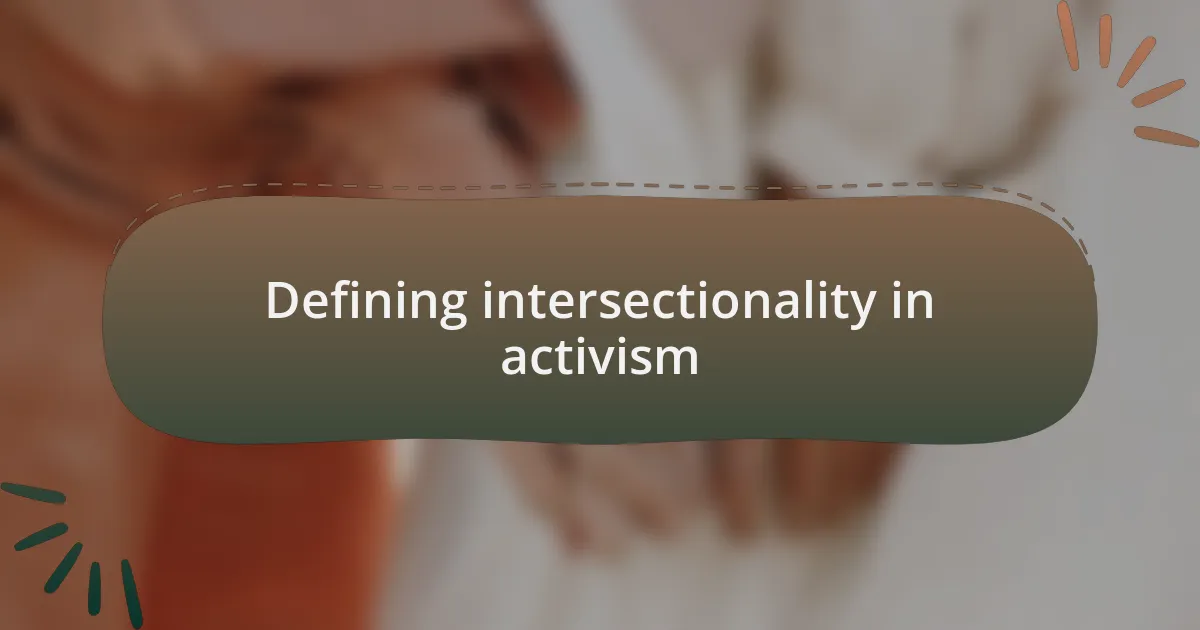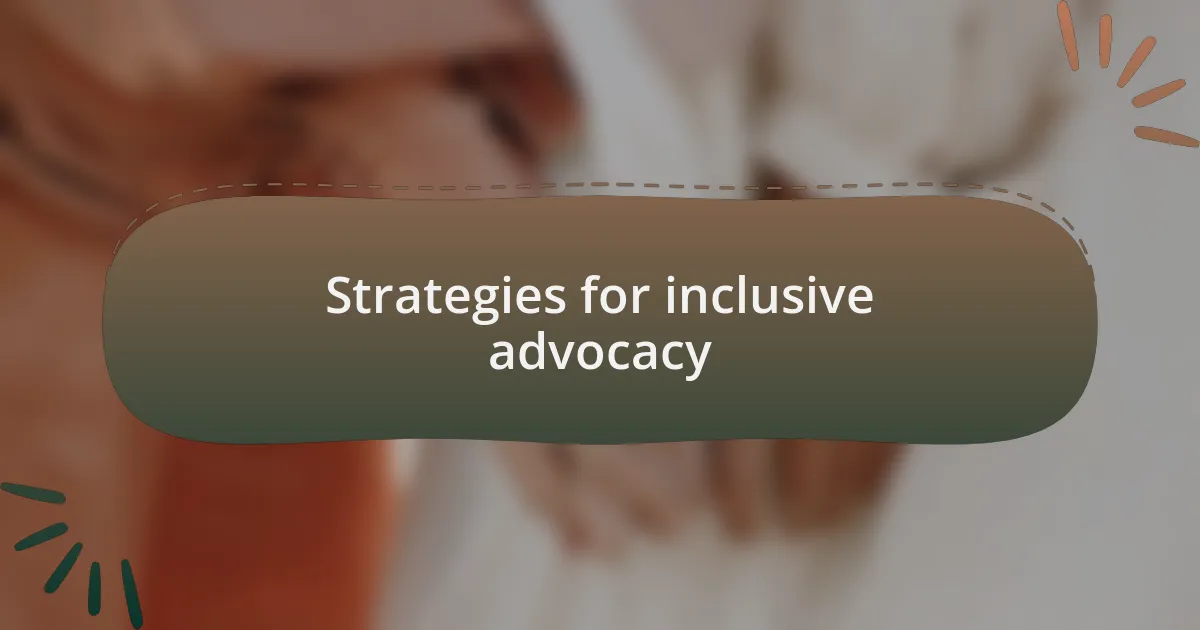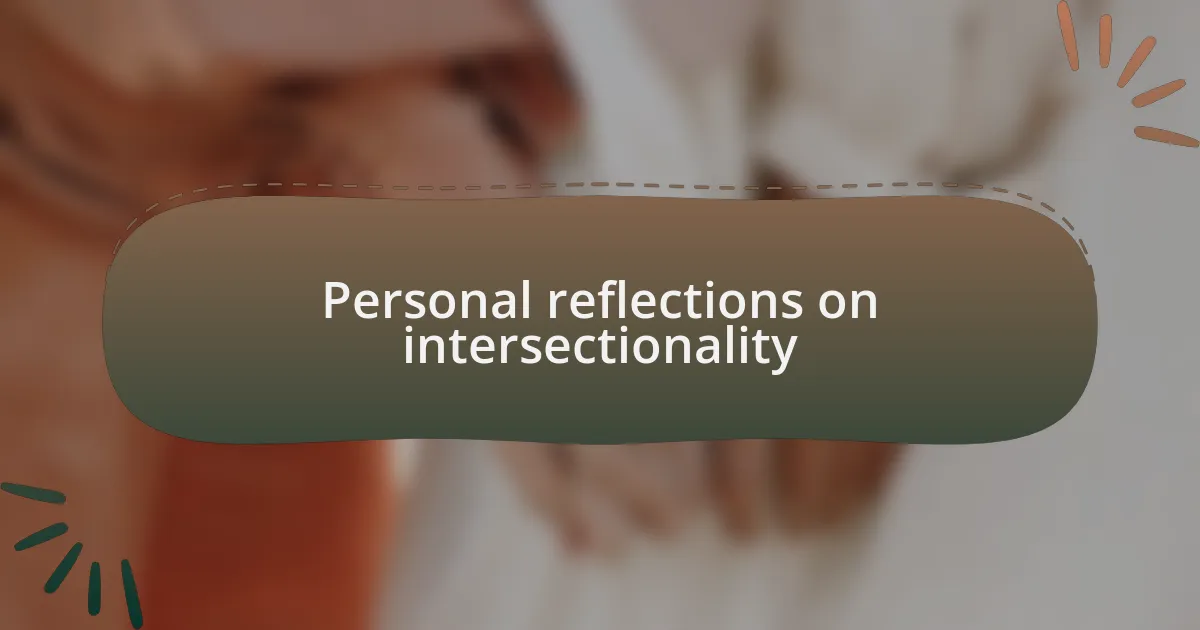Key takeaways:
- Gender equality advocacy should recognize the diversity of experiences across different identities, emphasizing the importance of intersectionality.
- Effective activism requires centering the voices of the most marginalized and fostering genuine dialogue among diverse groups.
- Challenges in intersectional activism include managing differing priorities and addressing tokenism while ensuring emotional well-being during discussions.
- Promoting intersectional approaches demands active listening, education on identity complexities, and embedding inclusivity into advocacy strategies.

Understanding gender equality advocacy
Gender equality advocacy goes beyond just promoting equal rights for women and men; it encompasses the diverse experiences of all genders and intersections of identities. Reflecting on my own journey, I remember instances where I felt marginalized within the movement, realizing that gender alone doesn’t define someone’s experience—factors like race, class, and sexuality create complex intersections that shape our realities. Isn’t it vital to acknowledge this complexity to truly champion equality for everyone?
The heart of gender equality advocacy lies in understanding and amplifying those voices that have been historically silenced. I recall attending a workshop where individuals shared their stories, and it struck me how much more powerful our collective activism became when we included their narratives. It’s a vivid reminder that everyone has a unique story that deserves to be heard—how can we work towards equality if we don’t embrace the full spectrum of human experiences?
To advocate effectively, we must challenge not only societal norms but also our own perceptions. I often find myself questioning my own biases and asking, “Whose voices am I elevating, and whose are being overlooked?” It’s through this critical self-reflection that we can foster a more inclusive movement, ensuring that gender equality advocacy truly represents and serves all members of our diverse society.

Defining intersectionality in activism
Intersectionality in activism refers to the understanding that various aspects of a person’s identity—such as race, gender, class, and sexuality—are interconnected and affect their experiences of oppression and privilege. When I first encountered this concept during a discussion on social justice, I was struck by how my own experiences as a woman were shaped differently by my socioeconomic background. It became clear that focusing solely on gender would paint an incomplete picture.
In my journey through activism, I often meet individuals whose stories highlight the impact of these intersecting identities. For instance, I remember a powerful conversation with a transgender person of color who described the unique challenges they faced that were distinct from those of both white women and cisgender individuals. Their story illuminated the necessity of intersectionality; it made me question, “How can we craft effective strategies if we don’t fully understand the complexities at play?”
Advocating for gender equality demands an intersectional lens because it recognizes that no single story can encapsulate the myriad ways people experience discrimination. I often reflect on how this understanding pushes me to think broadly about inclusivity. It’s a reminder that each person’s experience can teach us something invaluable—if only we listen deeply and thoughtfully.

Common challenges in intersectional activism
In my experience, one of the most common challenges in intersectional activism is the difficulty of uniting diverse groups with differing priorities. I recall being part of a coalition where each member brought their unique struggles to the table. It became evident that while we all sought justice, our definitions of that justice often diverged. How do we negotiate these differences without sidelining anyone’s voice?
Another challenge I frequently encounter is the risk of tokenism, where marginalized individuals are included in conversations more as symbols than as genuine contributors. I remember feeling frustrated when an organization invited me to speak at an event but neglected to involve others whose perspectives were equally important. It made me wonder, “Are we truly committed to intersectionality if we’re only paying lip service?”
Additionally, there’s the emotional toll that comes with navigating spaces that often feel hostile to intersectional discussions. Sometimes, I leave meetings feeling drained, as if the weight of everyone’s struggles rests heavily on my shoulders. This makes me think about how crucial it is for activists to engage in self-care and support one another. After all, if we don’t take care of ourselves and each other, how can we sustain our fight for justice?

Strategies for inclusive advocacy
One effective strategy for inclusive advocacy is fostering genuine dialogue between different groups. I remember participating in a workshop where everyone was invited to share their experiences and insights on gender inequality. This open exchange not only broke down barriers but also illuminated shared values, reminding us that collaboration thrives on understanding and respect. How often do we create spaces where every voice feels validated?
Additionally, actively centering the experiences of the most marginalized can help ensure that advocacy efforts are truly inclusive. I think back to a local campaign focused on housing rights that consistently highlighted the stories of those experiencing homelessness. Their narratives drove the campaign’s mission forward, compelling others to listen and engage with the issues on a deeper level. This raises a crucial question: Are we amplifying those essential voices in our advocacy work?
Lastly, integrating intersectionality into all aspects of our planning is key. I recall when I joined an organizing team that made it a point to consider how factors like race, class, and gender intersect in all our strategies. This approach allowed us to craft messages that resonated more broadly, creating a united front rather than fragmenting our efforts. Isn’t it time we ask ourselves how we can weave intersectionality into the very fabric of our advocacy?

Personal reflections on intersectionality
Intersectionality reminds me of a moment during a community forum where various identities were represented and shared their stories. Listening to a mother articulate the unique challenges she faced as a Black woman was both eye-opening and transforming for me. It made me realize how interconnected our experiences are and prompted me to think: how often do we overlook the complex layers that shape individual experiences in our advocacy?
Reflecting on my time volunteering at a shelter, I encountered women from diverse backgrounds, each with different struggles influenced by their identities. One woman’s story about navigating the healthcare system while dealing with discrimination struck a chord with me. It emphasized the importance of recognizing that advocacy is not a one-size-fits-all approach. Are we truly listening to the different narratives or simply assuming we understand their needs?
In a recent project, I engaged with activists who discussed the implications of erasing intersectional identities from our messaging. One participant poignantly asked, “What happens to those of us who don’t fit neatly into one category?” That question lingered with me long after the conversation ended, highlighting the necessity of clarity in our advocacy. It seems crucial to remember that our efforts should encompass all intersecting identities and not just serve a singular narrative.

Steps to promote intersectional approaches
To promote intersectional approaches, it is essential to actively listen to marginalized voices in our communities. I recall a discussion I had with a group of young activists where we explored the importance of creating inclusive spaces. One participant shared how their identity as a non-binary person influenced their experience in activism, an insight that made me question: Who else are we missing in our advocacy efforts?
Another critical step is to educate ourselves and others about the different layers of identity. I once attended a workshop that highlighted the intricacies of racial, economic, and gender identities. It opened my eyes to the privilege I carry and how it affects my perspective on issues. This experience reinforced my belief that the more we understand each other’s challenges, the better equipped we become to advocate for comprehensive change.
Finally, we need to ensure that intersectionality is woven into the foundation of our advocacy strategies. I’ve participated in campaigns that initially seemed well-intentioned but ultimately sidelined the needs of certain groups. It left me pondering: Are we genuinely committed to inclusivity, or are we just paying lip service? By embedding intersectional frameworks into our initiatives, we can create advocacy that truly resonates with diverse communities.